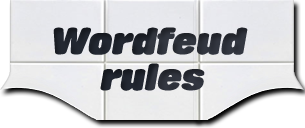Wordfeud Rules
Here we list the rules for playing Wordfeud. Most know how to play, but many doesn’t know about all the rules for the game, so they can’t utilize all possibilities at any given time in the game. These are the basic rules. Read in the Wordfeud Tips and Tricks section for tips on how to use these basic rules to maximize your Wordfeud score.
- 1. The player who invites to a Wordfeud game will start off the game. The first word have to cover the star in the middle of the board, but you don’t have to start with the first letter on the star.
- 2. When you choose a game you can either choose ‘random’ board or ‘standard’ board. Standard board means that it is a given board, with all special bonus positions/squares in the same place every time. DW, TW, DL and TL will always be in the same positions. A random board means that the DL, TL, DW and TW are placed at random every time. Random is more unpredictable, and will possibly give single word scores that can be extremely high, by combining the DL, TL, DW and TW positions. Some would say that it makes it more fun, as you can always catch up by getting a big score on a special word. The ´professionals´and tournaments play the standard board.
- 3. You can spell a word horizontally, spelling it to the right, or vertically spelling it downwards. It’s not allowed to spell upwards or to the left.
- 4. At least one of the tiles you play must be placed adjacent to an existing board tile, except when you start and you have to use the star in the middle.
- 5. Each player will receive 7 tiles to start, and you will refill up to 7 tiles when you use letters/tiles in the game, until there are no more tiles left to take from. There are a total number of 104 tiles in each game, as follows:
Letter Points Number of tiles a 1 10 b 4 2 c 4 2 d 2 5 e 1 12 f 4 2 g 3 3 h 4 3 i 1 9 j 10 1 k 5 1 l 1 4 m 3 2 n 1 6 o 1 7 p 4 2 q 10 1 r 1 6 s 1 5 t 1 7 u 2 4 v 4 2 w 4 2 x 8 1 y 4 2 z 10 1 Joker 0 2 - 6. The letters have a given value which is set (see table above), and the sum of the word will be the sum of the letter values. hen all tiles is used the game is over, or when the possible score for the player with the least amount of points (based on the tiles left and the possible words on the board) is less than the score of the opponent. You can also surrender at any given point in the game to finish it.
- 7. You have 72 hours to play a word. If you exceed this limit, you will lose the game.
- 8. A blank tile is a joker, and can represent any given letter, but will give 0 points to the sum of the word.
- 9. DL stand for Double Letter value. Any tile put on a DL will contribute to double the value of the letter to the total score for the word.
- 10. TL stands for Triple Letter value, and will triple the points of that specific letter.
- 11. DW stands for Double Word count. If you manage to cover a DW with your word, your total sum of that word will be double the value of all letters used.
- 12. TW stands for Triple
Word count. This will triple the score of your word.
* Letter multipliers are applied before considering word multipliers. - 13. So if you are able to get more than 1 of these bonus possibilities on 1 word, the score of your word will possibly be many times the sum of your letter values. If you cover 2 TW in 1 word, you will first triple the score, and then triple it again. This means 9 times the score of the word. So combine as many of the special bonus positions as possible.
- 14. If you manage to use all tiles/letters available (which is 7) in 1 play you trigger something called a ‘BINGO’. This adds 40 points to your total score for the word.
- 15. If a player is unable to form new words with the tiles at his disposal, he can instead choose to pass his turn to the opponent. If three passes are made in a row, the game will end and final scores are calculated according to the rules below.
- 16. A player can choose to swap one or more of his tiles instead of playing a word. Note that this is only possible if there are at least seven remaining tiles in the bag.
- 17. The game ends when one of the players has used all his tiles and there are no more tiles left in the bag, or after three consecutive passes. Points on remaining tiles are subtracted from each player's score, then added to the opponent's score if he used all his tiles.
- 18. Not a rule, but in the top right corner you have a ‘chat’ button. If you hit that you can write messages to your opponent for free. Nice way to chat with your friends while you play.
- 19. You can play against your family and friends by adding them, or they add you. If you want to have a random opponent, you can choose ´find player´and an available player in the network will be chosen for your game.
